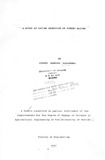| dc.description.abstract | Potato (Solarium tuberosum) is an underexploited tuber with promising economic value and the potential to help ease the world food problem. It produces more calories per unit area of land than other tropical root crops and tubers. For practical and efficient utilization, it must be processed into ration dense, stable forms. A study was made to process the Desiree variety into dried slices which could be stored at tropical ambient conditions for at least one year. The quality of the air dried slices were evaluated. Results indicate this approach to be feasible.
Forced-convection drying behaviour of potato slices was experimentally determined as a function of the drying air temperature, airflow rate and thickness of the slices under laboratory conditions.
Drying of potato slices is an unsteady-state process under the control of diffusion rate of water through the slice surface. Therefore, temperature, thickness of the potato slices and the drying air flow rate control the drying rate, in tnis work, the initial thickness of potato slices was kept constant at 2 mm, 4 mm and 6 mm and the effects of drying air temperature and airflow rate were investigated. Through the measurements of moisture content, colour and rehydration, actual drying behaviour of potato slices under different dryer conditions were determined. Colour and rehydraticn of the dried slices were used as criteria for the evaluation and determination of the optimum conditions.
Statistical analysis of experimental data showed the drying air temperature had the greatest effect on drying rate and quality, followed by slice thickness; air mass flow rate had little effect on the thin-layer drying rate. Specifically, drying rate was inversely proportional to the square of slice thickness at constant drying air temperature. Three-term drying equation models developed using the statistical method of successive residuals were considered sufficient for practical applications. A thin layer drying equation that can predict drying behaviour of potato slices was also developed.
The quality of the air dried slices were evaluated and a nonlinear model was developed for vitamin C degradation based on the applicability of the Arrhenius equation. | en_US |



